Keeping your roof in top shape is key to protecting your home. This guide helps homeowners tackle small roofing repairs with confidence. We’ll show you how to spot common issues, do basic maintenance, and know when to call the pros.
Learn to spot early warning signs during a roof inspection. You’ll get tips on DIY fixes to keep your roof strong. Our advice covers simple shingle replacements and fixing minor leaks. This helps extend your roof’s life and saves you from expensive repairs later.
Ready to become a savvy homeowner? Let’s explore small roofing repairs together. Discover how to protect your biggest investment.
Understanding Common Roofing Problems and Warning Signs

Spotting roof damage early can save you money and time. Knowing how to identify issues helps you fix them before they get worse. Let’s look at the signs that your roof might need some care.
Visual Signs of Roof Damage
Regular checks can find visible damage. Look for missing, cracked, or curled shingles. These need quick roof leak repair to stop water damage.
Dark spots or worn-off granules are also warning signs. Don’t ignore them.
Interior Warning Signals
Water stains on ceilings or walls mean a leaky roof. Peeling paint or bubbling wallpaper also show moisture issues. A musty smell in the attic means water is trapped, creating mold conditions.
Weather-Related Damage Indicators
After bad weather, check for storm damage. High winds can lift shingles, and hail can cause dents or cracks. Fallen tree limbs or debris can puncture the roof, leading to leaks.
Being watchful and fixing issues early keeps your roof in good shape. If you’re not sure about your roof, get a professional to check it. Early action can prevent expensive replacements later.
Essential Tools and Safety Equipment for Small Roofing Repairs
Small roofing repairs need the right tools and safety gear. Whether it’s roof patching or shingle replacement, being ready is important. Let’s look at the key items for a safe and good repair job.
- Hammer and pry bar
- Utility knife
- Roofing nails
- Caulking gun
- Roofing cement
Safety is the most important thing when working on your roof. Get quality safety equipment:
- Sturdy ladder
- Non-slip boots
- Safety harness
- Hard hat
- Safety glasses
For shingle replacement, you’ll need a chalk line and roofing shovel. For roof patching, have a trowel and patch kit ready. Always use safety gear right. Make sure your harness is secure and wear protective gear to avoid accidents.
Before starting, check your tools and safety gear for damage. Replace anything that’s worn out to stay safe. With the right tools and safety steps, you can confidently do small roofing repairs and keep your home safe.
Addressing Shingle Damage and Replacement
Shingle damage can cause big problems if ignored. Knowing how to spot and fix issues can save you money. Let’s look at how to replace shingles and pick the best materials.
Identifying Damaged Shingles
Check for curled edges, cracks, or missing granules on your shingles. Dark spots or bare patches mean they’re worn out. If you see these signs, it’s time to replace them.
Step-by-Step Shingle Replacement Process
Begin by taking out the damaged shingle. Lift the edges of nearby shingles and remove the nails. Then, slide out the old shingle and put in the new one.

Material Selection Guidelines
Choose materials that match your roof. Think about climate, durability, and cost. Asphalt shingles are affordable and easy to put on. Metal or slate last longer but cost more.
- Match color and style to existing shingles
- Consider weight capacity of your roof structure
- Factor in local weather conditions
While small repairs can be DIY, big jobs need a pro. They ensure your roof is installed right and stays strong.
Quick Fixes for Roof Leaks and Water Damage
Roof leaks can happen anytime, causing water damage and stress for homeowners. Quick action is key to stop more damage. Here are some emergency fixes for roof leaks and water damage.
First, find where the leak is. Look for water stains on ceilings or walls. These usually show where the leak is. Once you find it, cover the area from outside with a tarp. Make sure the tarp is tight to keep water out during rain.
Inside, put buckets under leaks to catch water. This can save your floors and furniture from damage. For small leaks, use roofing cement or sealant. These products make a quick fix until a pro can fix it for good.
Keep in mind, these fixes are just temporary. They help in emergencies but you need a pro to fix it right. A roofing expert can check the damage and fix it for good. They’ll keep your home safe from leaks and water damage.
Small Roofing Repairs You Can DIY
Many homeowners can handle small roofing repairs by themselves. Doing DIY roof repairs and maintenance can save money and make your roof last longer. Let’s look at some tasks you can do on your own.
Basic Maintenance Tasks
Keeping your roof in good shape is important to avoid big problems. Here are some tasks you can do:
- Clear debris from gutters and roof valleys
- Trim overhanging tree branches
- Check for loose or missing shingles
- Inspect flashing around chimneys and vents
Simple Repair Techniques
For minor issues, try these DIY roof repairs:
- Replace damaged shingles
- Seal small leaks with roofing cement
- Reattach loose flashing
Always be careful when working on your roof. Use the right tools and avoid DIY repairs in bad weather. For more detailed guidance on DIY roof repairs, check out this DIY roofing guide.
When to Call a Professional
While DIY roof maintenance can save money, some issues need a roofing expert. Call an expert if you notice:
- Large areas of damage
- Persistent leaks
- Structural issues
- Extensive water damage
Remember, safety is the most important thing. If you’re not sure about a repair, it’s best to contact a professional roofer in your area.
Maintaining Roof Flashing and Seals
Keeping your roof’s flashing and seals in good shape is key. They help protect your home from water damage. Regular checks and quick repairs can prevent expensive fixes later.
Flashing is thin metal that keeps water away from your roof’s weak spots. You’ll find it around chimneys, vents, and skylights. If it gets loose or damaged, it can cause leaks. So, fix any wear and tear right away.
Vent pipe sealing is also vital. These seals stop water from getting into your home through vent pipe gaps. Check them often for cracks or wear. Replace them when needed to keep your roof dry.
Don’t overlook chimney cap installation. A good chimney cap keeps rain out and stops animals from nesting. It’s a simple step that can help your chimney and roof last longer.
- Check flashing for rust, gaps, or loose sections
- Inspect vent pipe seals for cracks or wear
- Ensure chimney caps are secure and intact
- Address any issues promptly to prevent water damage
By keeping up with these maintenance tasks, you can ensure your roof stays in great shape. Avoiding costly repairs is easier. If you’re not sure how to do these tasks, call a professional roofer for help.
Gutter System Maintenance and Repairs
Keeping your gutters in good shape is key to protecting your home from water damage. Regular cleaning and upkeep can save you from expensive fixes later on. Let’s look at how to keep your gutters working well.
Gutter Cleaning and Inspection
Clean your gutters at least twice a year. Take out leaves and twigs to ensure water flows right. While cleaning, check for any wear or damage.
Common Gutter Problems
Gutters can face many issues over time. Clogged gutters can cause water to overflow and damage your foundation. Sagging gutters might be due to loose fasteners or too much weight.
Leaks often show up at seams or corners. Sometimes, you might need to fix the soffit if water gets behind the gutters.
Repair Solutions
For small leaks, use gutter sealant on joints and seams. If that doesn’t work, replace the damaged parts. Tighten or replace fasteners to fix sagging gutters.
If you see big damage or feel unsure about fixing it, call a pro for gutter care.

Remember, taking care of your gutters is a big part of keeping your home in good shape. By keeping up with cleaning and fixing problems fast, you can avoid water damage and make your gutters last longer.
Conclusion
Keeping your roof in good shape is key for both homes and businesses. This guide has given you the tools to handle small repairs on your own. You now know how to spot problems and do basic upkeep.
While fixing things yourself can save money, some jobs need a pro. For tricky issues or safety risks, it’s best to call in the experts. Straight Forward Construction located in Central Florida is here to help.
Don’t let small problems turn into big headaches. Book a free roof inspection today to keep your place safe. Our team at Straight Forward Construction is ready to help with all your roofing needs. Let us ensure your roof stays strong and safe for many years.





